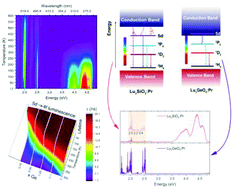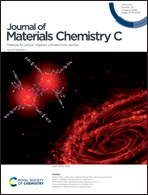Exploiting bandgap engineering to finely control dual-mode Lu2(Ge,Si)O5:Pr3+ luminescence thermometers†
Abstract
It was proved quite recently that luminescence thermometry may benefit from utilizing the 5d → 4f/4f → 4f intensity ratio of Pr3+ transitions. This paper presents a comprehensive study of Lu2(Gex,Si1−x)O5:Pr phosphors in the full range of Ge concentrations (x = 0–1) for luminescence thermometry. Silicon substitution by germanium allows effective management of their thermometric properties through bandgap engineering. The Ge/Si ratio controls the range of temperatures within which the 5d → 4f Pr3+ luminescence can be detected. This, in turn, defines the range of temperatures within which the 5d → 4f/4f → 4f emission intensity ratio can be utilized for thermometry. Altogether, the bandgap engineering allows widening the operating range of thermometers (17–700 K), fine-tunes the range of temperatures with the highest relative sensitivity, and reduces the inaccuracy of the measurements. The kinetics of the 5d → 4f luminescence is also controlled by bandgap engineering and can be also used for luminescence thermometry. The Lu2(Gex,Si1−x)O5:Pr phosphors were, thus, designed as dual-mode luminescence thermometers exploiting either the inter- and intra-configurational intensity ratios or the 5d → 4f decay time. The highest relative thermal sensitivity, 3.54% K−1, was found at 17 K for Lu2(Ge0.75,Si0.25)O5:Pr and at 350 K for Lu2SiO5:Pr and it was combined with a very low (<0.03 K) temperature uncertainty. Herein, we proved that bandgap engineering is a promising and effective approach to developing high-performance luminescence thermometers.



 Please wait while we load your content...
Please wait while we load your content...